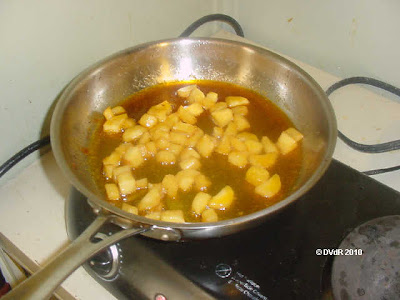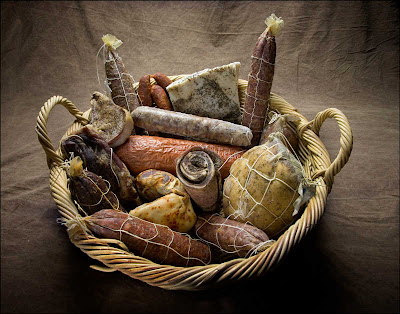 |
| My new slow cooker |
I have a new slow cooker, and it is lousy. It overcooks, scorches and burns. At first I just thought I had a cheap cooker, but then I began to hear my friends voicing the same concerns. It appears the Powers That Be have decided they know more about what is right for me than I do. The old slow cooker I had for years finally died and I had to buy a new one. They are all the same except for looks and control gadgetry, right? Well the answer is Yes... and No.
Yes, the new models all work just about the same... and No, they do NOT work like the old ones! They get much hotter, to the point of abusing the food in them.
Every person who has ever packed picnic food, or who has canned food at home, or made cured meats knows there is a DANGER ZONE in food for safety. That danger zone is between 40ºF and 140ºF, because it is within that temperature range that the pathogens proliferate. (Bacteria that cause disease are called pathogens; not all bacteria are pathogens however. When certain pathogens enter the food supply, they can cause foodborne illness.) That's why our refrigerators are designed to keep foods chilled below 40ºF (or frozen to 0ºF or below). Pathogens will still grow at low temps, just very slowly. Cooked foods need to reach at least 140ºF to kill any pathogens in them, and kept at 140ºF or warmer after being cooked, OR chilled to below 40ºF.
Water is pasteurized at ~150ºF and food is pasteurized at ~160ºF. Note that pasteurized means the destruction of all bacteria that may be harmful to health (pathogens). There are two primary methods of pasteurization: the liquid can be heated to 145ºF and held there for at least thirty minutes, or the liquid can be flash pasteurized at 161ºF for a minimum of 16 seconds. After pasteurization, bacteria can still appear. It is important that foods be safely handled and stored at every step of the supply process from animal, fruit or vegetable to stomach. In most cases, after food is pasteurized it should be refrigerated.
After pasteurization, bacteria can still appear. It is important that foods be safely handled and stored at every step of the supply process from animal, fruit or vegetable to stomach. In most cases, after food is pasteurized it should be refrigerated. Keep cold foods cold. Keep hot foods hot.
Fish is cooked at 125º-140ºF; beef is cooked at 145º-170ºF; pork is cooked at 160º-170ºF and chicken is cooked at 165º-180ºF. According to the USDA Food Safety and Inspection Service (FSIS), the recommended minimum temperatures, to kill off potentially harmful bacteria are:
* Beef, veal, and lamb steaks, roasts and chops: 145ºF
* All cuts of pork: 160ºF
* Ground beef, veal and lamb: 160ºF
* All poultry: 165ºF
* When reheating cooked food, heat to a minimum internal temperature of 165ºF.
The older slow cookers generally had a temp range on the low setting of around 185ºF, which was acceptable even if a bit high for slowly cooking foods over a long time. Newer slow cookers generally heat to something over 200ºF on the low setting, and over 300ºF on the high setting. I couldn't find the average temp for the "keep warm" setting, but my new slow cooker simmers with tiny bubbles on "warm". There is a thread on one of the forums I read about the newer slow cookers. NO ONE is happy with them. They now cook with higher temps that overcook and sometimes burn the food.
I decided to check out the heat range in my new cooker by filling it 2/3 full with warm water (115ºF) and see what it actually does. I started it on HIGH, as I would do for food. Note, times are from the beginning, or from the previous change in temperature setting, NOT from the previous reading.
Initial water temp: 115ºF
Set Temp Control to HIGH
After 1 hour: 160ºF
After 1½ hours: 175ºF
After 2 hours: 200ºF
I decided to check out the heat range in my new cooker by filling it 2/3 full with warm water (115ºF) and see what it actually does. I started it on HIGH, as I would do for food. Note, times are from the beginning, or from the previous change in temperature setting, NOT from the previous reading.
Initial water temp: 115ºF
Set Temp Control to HIGH
After 1 hour: 160ºF
After 1½ hours: 175ºF
After 2 hours: 200ºF
After 3 hours: Boiling, 212ºF
Reduced Temp Control to LOW
One hour later: 200ºF
Two hours later: 200ºF
Three hours later: 200ºF.
Reduced Temp Control to KEEP WARM
One hour later: 175ºF
Two hours later: 175ºF
Three hours later: 175ºF
Reduced Temp Control to LOW
One hour later: 200ºF
Two hours later: 200ºF
Three hours later: 200ºF.
Reduced Temp Control to KEEP WARM
One hour later: 175ºF
Two hours later: 175ºF
Three hours later: 175ºF
I am going to let it cool down overnight, and start again set to WARM tomorrow. I need to know if 175ºF is the temp it will heat to initially after setting just to WARM, or if that's the temp a cooked food will cool down to and then stay there to keep warm.
My, my... how interesting (and possibly dangerous)! I started my slow cooker on KEEP WARM, with the cooled water from last night, now @ 75ºF.
One hour later: 100ºF
Two and Three hours later: 125ºF
One more hour: about 150ºF, and a bit higher (165ºF) as the heat cycled on.
Then I turned the control to LOW
In one hour, it went to 175ºF
In another hour, it went to 180ºF
In another hour, it jumped to 200ºF, and stayed there all night.
Here are my conclusions:
1. Using the HIGH setting is clearly too high, and overcooks.
2. Starting on LOW with something already lukewarm still cooks it too hot to suit me, although it takes almost 2 hours to get to 200º. It will maintain 200º as long as it is turned on.
3. Starting a refrigerator-temp meat on KEEP WARM has the meat in the DANGER ZONE (40ºF - 140ºF) for far too long, over 4 hours. But then it keeps it between 150º and 170º.
So, what seems safe to me now, is to begin with a heated liquid (over 140º) and perhaps browning any meat before putting it in the warm liquid in my slow cooker, and setting it to Keep Warm, where it will stay in the 150º-170ºF range. I will be satisfied (but not happy that it's not like my old one), and feel my foods are safe and not overcooked or burned by doing it this way.
Research shows the common causes of food poisoning in the home are generally due to unsanitary conditions, and leaving cooked foods or raw fish and meat at room temperatures too long. There are occasionally reports of food poisoning from undercooking foods, but no data linking between those undercooked foods and a slow cooker!



































